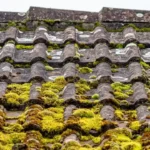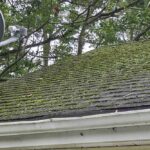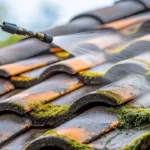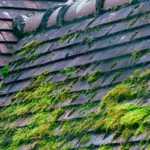Many homeowners find themselves asking, how to scrub moss off roof safely? Moss on roofs is an issue that can affect the longevity and appearance of your home. Fortunately, there are ways to address this problem effectively while ensuring your safety. In this article, we will discuss the best methods to remove moss from your roof, keeping in mind both safety and efficiency.

Understanding Moss Growth on Roofs
Moss thrives in damp, shaded environments, making rooftops a prime location for its growth, especially in areas with high humidity and frequent rainfall. Over time, moss can damage roofing materials, leading to leaks and structural issues. To learn more about the problems caused by moss, visit Moss on Roof Problems.
Why Its Important to Remove Moss
While moss may give your home a quaint, rustic look, it can cause significant damage if left untreated. Moss retains moisture, which can lead to rot and decay of roofing materials. This not only shortens the lifespan of your roof but also increases the risk of leaks and water damage. Additionally, moss can dislodge shingles, making your roof more vulnerable to harsh weather conditions.
Safety Precautions Before Scrubbing Moss
Before you begin the process of removing moss, it’s crucial to ensure your safety. Working on a roof can be dangerous, so taking the right precautions is essential. Here are some safety tips to keep in mind:
Use Proper Safety Gear
Always wear slip-resistant shoes and a harness to prevent falls. Wearing gloves and safety glasses will also protect your hands and eyes from debris and cleaning solutions.
Check Weather Conditions
Avoid working on the roof during wet or windy conditions. A dry, calm day is ideal for scrubbing moss off your roof.
Effective Methods for Removing Moss
Manual Removal
For small areas, manually removing moss with a stiff brush can be effective. Gently scrub the moss in a downward motion to avoid lifting shingles. Be careful not to damage the roofing material.
Pressure Washing
Pressure washing can be a quick way to remove moss, but it must be done carefully to avoid damaging the roof. It’s best to use a low-pressure setting and aim the spray downward. For more tips on cleaning your roof naturally, visit How to Clean Moss Off Roof Naturally.
Chemical Treatments
There are various chemical solutions available for killing moss. These treatments can be sprayed onto the roof and left to work over time. Ensure that any chemicals used are safe for your roofing material and the environment. For eco-friendly removal options, check out Eco-friendly Roof Moss Removal.
Preventing Future Moss Growth
Once you’ve removed the moss, taking steps to prevent its return is vital. Consider trimming overhanging branches to reduce shade and improve sunlight exposure on your roof. Installing zinc or copper strips can also deter moss growth. To explore more DIY prevention methods, click Roof Moss Treatment DIY.
Professional Help
If you’re unsure about handling the moss removal yourself, or if the moss is extensive, hiring a professional roofing service may be the best option. Professionals have the tools and experience needed to safely and effectively remove moss from your roof.
Conclusion
Keeping your roof free of moss is essential for maintaining its integrity and appearance. By understanding how to scrub moss off roof safely and taking preventive measures, you can protect your home from potential damage. Remember, safety should always be your top priority when working on a roof.

FAQ Section
1. Can I use vinegar to remove moss from my roof?
Yes, vinegar is a natural solution that can be effective in killing moss. However, it may take multiple applications, and care should be taken to avoid contact with plants and landscaping.
2. How often should I check my roof for moss?
It’s a good idea to inspect your roof for moss at least once a year, especially if you live in a damp or shaded area.
3. Is moss on my roof a sign of a bigger problem?
Not necessarily, but it can lead to bigger issues if not addressed. Regular maintenance and inspections are key to preventing moss-related damage.
For more insights on why roofs develop moss, refer to this external resource.
This article contains affiliate links. We may earn a commission at no extra cost to you.








